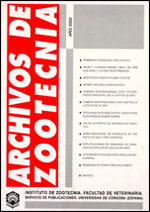Ver ítem
- xmlui.general.dspace_homeCentros Regionales y EEAsCentro Regional Patagonia NorteEEA BarilocheArtículos científicosxmlui.ArtifactBrowser.ItemViewer.trail
- Inicio
- Centros Regionales y EEAs
- Centro Regional Patagonia Norte
- EEA Bariloche
- Artículos científicos
- Ver ítem
Caracterización de la lana de ovejas criollas argentinas en cuatro ambientes diferentes
Resumen
La raza ovina Criolla es la fundadora del patrimonio ovino argentino y está distribuida en casi todas las provincias. Son pocos los trabajos destinados a estudiar la calidad lanera de este germoplasma. El objetivo fue caracterizar la lana de ovejas Criollas Argentinas, utilizando las principales medidas que determinan su calidad y su valor comercial. El muestreo se realizó sobre majadas ubicadas en cuatro provincias: Salta (SA) (n= 44); Santiago del
[ver mas...]
La raza ovina Criolla es la fundadora del patrimonio ovino argentino y está distribuida en casi todas las provincias. Son pocos los trabajos destinados a estudiar la calidad lanera de este germoplasma. El objetivo fue caracterizar la lana de ovejas Criollas Argentinas, utilizando las principales medidas que determinan su calidad y su valor comercial. El muestreo se realizó sobre majadas ubicadas en cuatro provincias: Salta (SA) (n= 44); Santiago del Estero (SE) (n= 60); Corrientes (CO) (n= 40) y Buenos Aires (BA) (n= 59). Se tomaron muestras de lana de cada oveja y se determinaron las siguientes variables: diámetro medio de fibra (DMF); desvío estándar del diámetro medio de fibra (DE_DMF); curvatura de ondulación (CU); factor de confort (FC) y largo de mecha (LM). El análisis estadístico incluyó análisis de varianzas (ANOVA), análisis de componentes principales (ACP) y de conglomerados (ACO). Las ovejas SA se destacaron del resto de las regiones por su menor DMF= 26,1±2,5 µm y DE_DMF= 6,2±1,5 µm, su mayor CU= 78,5±13,5 º/mm y su mayor FC= 78,8±12,7 %, mientras que las de BA presentaron un LM= 123,0±36,6 mm, ampliamente superior a las otras regiones y CO presentó mayor DMF= 35,9±4,1 µm. El ACP identificó 2 componentes que explicaron el 90 % de la variabilidad. La primera diferencia SA de BA y muestra superposición entre SE y CO. La segunda diferencia BA del resto de las regiones. Del ACO surge que los ovinos de SE y CO forman un solo grupo definiéndose tres regiones: SA, BA y SE-CO. Ninguno de los tres grupos respondió a la categoría carpet-wool o Criola correspondiente a la clasificación lanera oficial, por eso se considera necesario construir un mapa lanero Criollo de la República Argentina.
[Cerrar]
The Creole sheep breed is the founder of the argentine sheep heritage and it widespreads
through almost all the provinces. There are few studies aimed at assessing this germplasm’s
wool quality. The objective was to characterize the Creole Argentinean sheep’s wool, by
using the main measures that determine its quality and commercial value. The sampling concerned flocks located in all the four provinces: Salta (SA) (n= 44); Santiago del Estero (SE)
(n=
[ver mas...]
The Creole sheep breed is the founder of the argentine sheep heritage and it widespreads
through almost all the provinces. There are few studies aimed at assessing this germplasm’s
wool quality. The objective was to characterize the Creole Argentinean sheep’s wool, by
using the main measures that determine its quality and commercial value. The sampling concerned flocks located in all the four provinces: Salta (SA) (n= 44); Santiago del Estero (SE)
(n= 60); Corrientes (CO) (n= 40) and Buenos Aires (BA) (n= 59). Wool samples were taken
from each sheep and the following variables were determined: mean fibre diameter (DMF);
standard deviation of the mean fibre diameter (DE_DMF); mean fibre curvature (CU); comfort
factor (FC) and staple length (LM). The statistical analysis included analysis of variance (ANOVA), principal components analysis (PCA) and cluster analysis (CA). The sheep from SA stood
out from the ones from the rest of the regions because of their low DMF= 26,1±2,5 µm and
DE_DMF= 6.2±1.5 µm, their higher CU= 78.5±13.5 º/mm and FC= 78.8±12.7 %, while
the ones from BA presented a LM= 123.0±36.6 mm value, which was remarkably higher
than the ones from the other regions and CO, which showed a higher DMF= 35.9±4.1 µ.
The PCA highlighted two components that explained the 90% of the variability. The first one
distinguishes SA from BA and shows the existing overlap between SE and CO. The second
one differentiates BA from the rest of the regions. From the CA, it can be concluded that the
sheep from SE and CO formed only one group, what defined three regions: SA, BA and
SE-CO. None of the three regions responds to the carpet-wool o Criolla category according to the official wool classification, for that reason, it is necessary to build a Creole wool map for the Argentine Republic.
[Cerrar]

Autor
Peña, S.;
Sacchero, Diego Mariano;
Maurino, Maria Julia;
Lopez, G.A.;
Abbiati, Nora Nidia;
Género, E.R.;
Martínez, R.D.;
Fuente
Archivos de Zootecnia 65 (249) : 13-19. (2016)
Fecha
2016
Editorial
Servicio de Publicaciones Universidad de Córdoba, España
ISSN
1885-4494
Formato
pdf
Tipo de documento
artículo
Palabras Claves
Derechos de acceso
Abierto
 Excepto donde se diga explicitamente, este item se publica bajo la siguiente descripción: Creative Commons Attribution-NonCommercial-ShareAlike 2.5 Unported (CC BY-NC-SA 2.5)
Excepto donde se diga explicitamente, este item se publica bajo la siguiente descripción: Creative Commons Attribution-NonCommercial-ShareAlike 2.5 Unported (CC BY-NC-SA 2.5)


